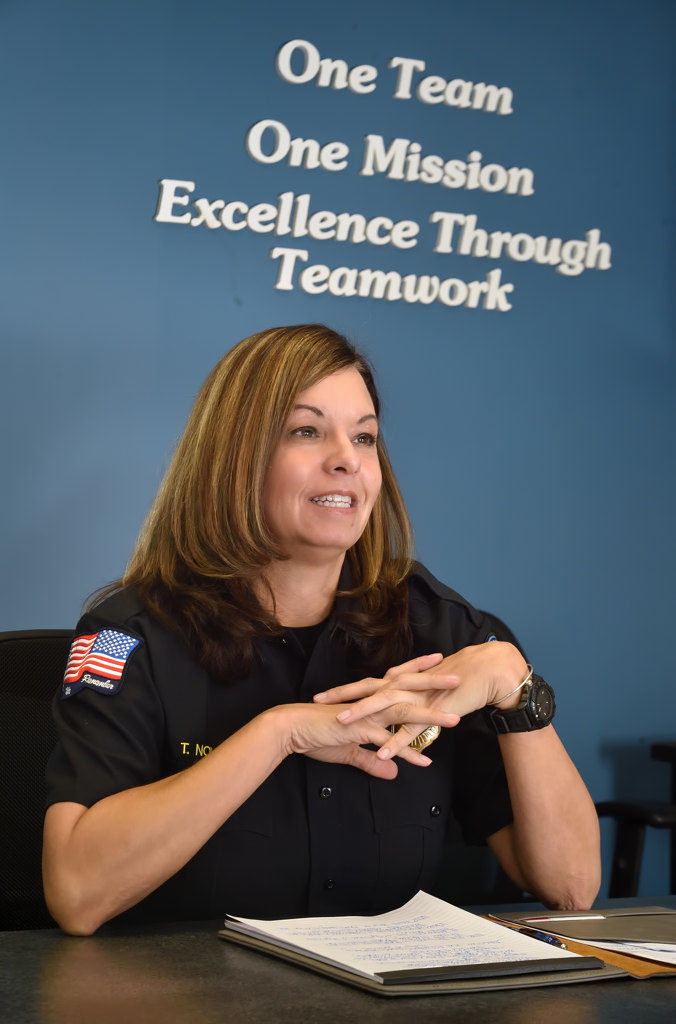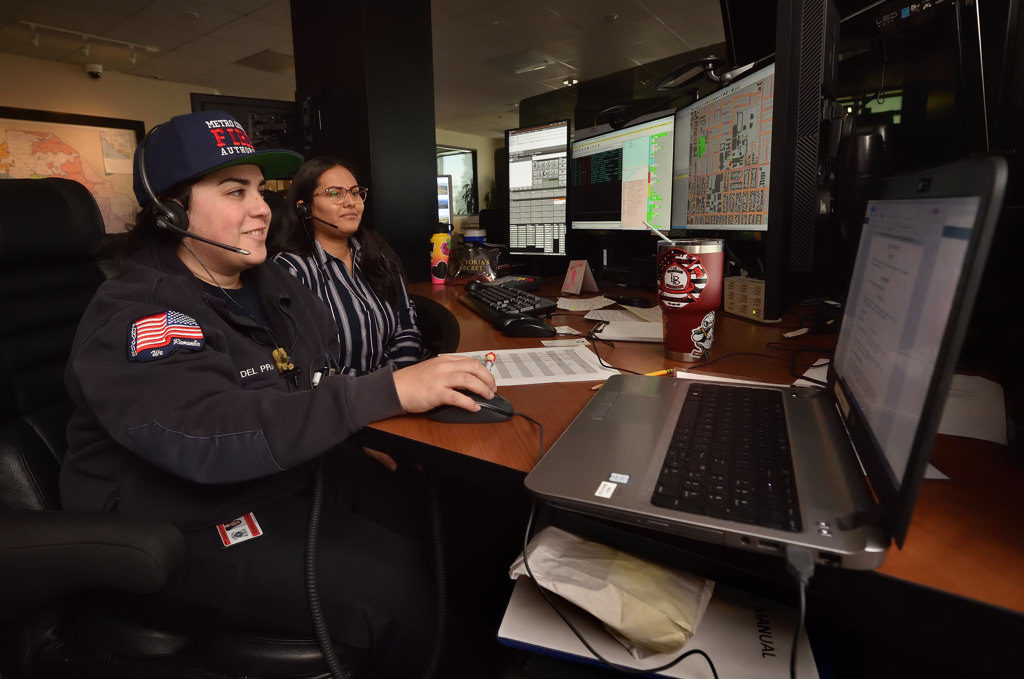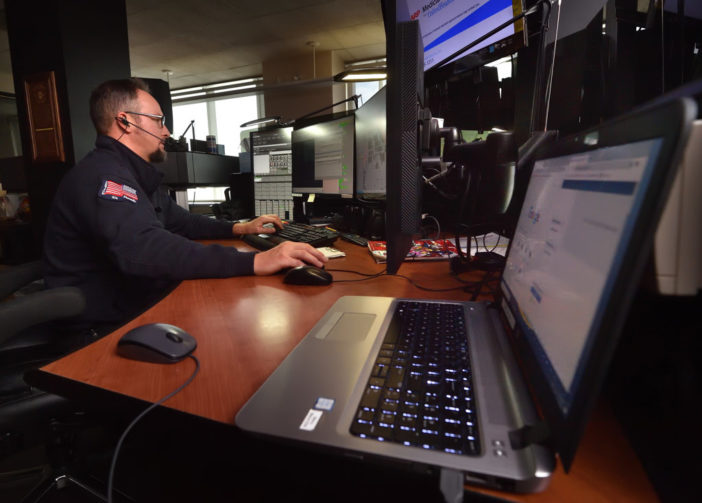Twenty-five years ago, when Tracy Nolan began her career as a dispatcher with the Buena Park PD, answering 911 calls was very different than it is today.
Back then, virtually all emergency calls came from landlines; only a fraction came from what now seem like brick-sized mobile phones, compared to today’s amazingly powerful (and small) smart gadgets.
Today, 80 percent of all 911 calls are made from mobile phones, says Nolan, citing a national statistic. Nolan now is administrative supervisor at the Metro Net Fire Dispatch call center in Anaheim, which in addition to Anaheim handles fire emergency phone calls for six other O.C. cities that are part of a joint-powers authority.
The job of a Metro Net dispatcher today makes 25 years ago seem like the dark ages.
In addition to the dramatic shift to 911 calls from cell phones, which despite common perception do not provide the exact locations of callers (more on that later), dispatchers countywide recently were introduced to the new Text to 911 system.
Text to 911 went live in O.C. on Feb. 8, 2019.
Although Metro Net, whose dispatchers answer some 275,000 fire emergency calls a year, only is averaging about one text-to-911 call a month, the technology works well and only will get better, Nolan says.
Dispatchers eventually will be able to open photos and sound files sent by text. Because of concerns about malware and other issues, current protocol limits text-to-911 calls to text messages only, Nolan says.
On a recent day shift, Nolan sat down at a dispatch station to show how Text to 911 works. She also took a live call from – no surprise here – someone using a mobile phone.
Countywide, police and fire emergency dispatch agencies agreed to not integrate Text to 911 into their existing systems. Rather, a separate laptop is used.
When a text-to-911 call comes in, a distinct chime rings out. A dispatcher then communicates back and forth with the person via text, using pull-down menus with set phrases to save keystrokes.
The dispatcher then inputs the information into the CAD system at their console from the laptop exchange.
It’s not a perfect system, Nolan notes.
“Making a live call always is the best option,” Nolan says. “Typing a message is always going to take longer than speaking to somebody. Also, because the Text to 911 system is on a separate laptop, we have to transfer the information over to our computer to send the call out for service, and by doing that we run the risk of human error.”
Adds Nolan: “If you have someone that’s in cardiac arrest, I can’t efficiently type you instructions for CPR over your phone. It’s not going to work in a timely manner. I need you to call.”
Nolan has been a police and fire dispatcher for 25 years – the last 12 ½ years at Metro Net, where she worked her way up to administrative supervisor two years ago.
Metro Net and other fire dispatch agencies are known as secondary Public Safety Answering Points (PSAPs), meaning the 911 calls they get are routed from police agencies, who get the calls first. So it makes sense that text-to-911 calls are much more prevalent at police dispatch centers.
At Metro Net, two dispatchers always are logged in at the same time to the Text to 911 laptop system, which was introduced to serve deaf, hearing-impaired or speech-impaired people experiencing an emergency, as well as callers whose safety would be threatened if they had to talk.
The Text to 911 system has a mapping function – but unlike 911 calls from landlines, it’s not exact.
“We still have to verify the location they’re texting from,” Nolan explains. “We want to verify the city, we want to verify the cross streets. We want to make sure that we have all that information to make sure we’re sending our first responders to the correct location in a timely manner.”
Dispatchers can track a person texting a 911 call up to five times to track the route they are taking, Nolan says. And dispatchers, of course, can transfer text-to-911 calls to other agencies if they need to.

Metro Cities Fire Authority Administrative Supervisor Tracy Nolan talks about the new Text to 911 system and how it can be helpful to some people. Photo by Steven Georges/Behind the Badge
911 CALLS FROM MOBILE PHONES
There’s a popular perception, Nolan says, that if you use a cell phone to make a 911 voice call, the dispatcher will know your exact location.
Not true – and the same applies to text-to-911 calls.
“People always think we know their location on cell phones when they call in,” Nolan says. “And that’s not true because your cell phone signals are hitting off of a tower.”
They have a very good idea of where the mobile caller is located, Nolan adds – and, sometimes, the mapping hits on where the caller is exactly – but most of the time, the dispatcher typically can pinpoint to within 100 feet of where the call is coming from.
“And with cell phones, you’ve got signal quality issues, you have drop call issues,” Nolan adds. “You may have pretty good quality on your phone, but as soon as you hook up to a Bluetooth device or a hands-free device in your car, the call can easily become garbled and we can’t understand it as well.”
By 2021, Nolan says, the Federal Communications Commission wants all nationwide carriers to have horizontal location accuracy within 55 yards for 80 percent of 911 calls. Now, the accuracy depends on the carrier, Nolan says.
With next-generation technology, which involves 911 systems switching from analog to digital or to IP-based systems, the accuracy will get even better, Nolan says.
“The accuracy has improved greatly and it continues to improve with technology,” Nolan says. “With next-gen 911, you’re going to improve the safety of the civilians, you’re going to improve the safety of patients. You’re also going to improve the safety of your first responders getting there as well.
“You’re going to enhance emergency services. The system is going to be more resilient.”

Metro Net Dispatcher Amanda Del Prato, left, helps train Veronica Burks in receiving the title of Dispatcher II as a Text to 911 laptop computer is logged in ready to receive text-to-911 calls. At least two Metro Net dispatchers are always logged in and ready to receive a 911 text message.
Photo by Steven Georges/Behind the Badge
 Behind the Badge
Behind the Badge



